
LYBROOK BADLANDS
BY MICHAEL RICHIE
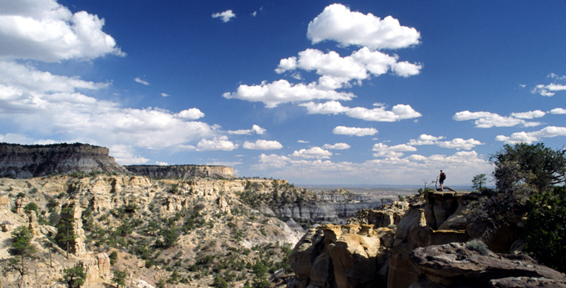
FROM: “Lybrook Badlands,” New Mexico Magazine , Nov. 2004, with 2 color photos.
AND: “The Lybrook Badlands,” Inside/Outside Southwest Magazine published by the Durango Herald , July/August 2007, with 5 color photos.
Walking the mesa edge in Lybrook badlands is a trip through a superbly xeriscaped, avant garde sculpture park with exhilarating aerial views. It’s also a very sinuous path. Long, thin sandstone fingers stretch out across crumbling grey hoo doo galleries below. The colorful sandstone rim itself sports the most diverse collection of precariously balanced, red cap-rocked hoo doos I’ve ever seen. These aerodynamically designed sculptures ranging in size from monumental to petite are so ingeniously shaped that they appear created in a Santa Fe studio rather than by natural forces. Character laden, bonsai ponderosa and picturesque old junipers clinging to bare rock greatly enhance the artwork.
My first visit several years ago to the Lybrook badlands brought astonishment tinged with embarrassment. I’d passed through Lybrook Village on 550 south of Bloomfield numerous times over the years with no inkling that anything like this lay less than a mile from the highway. After many return trips, Lybrook has become my favorite San Juan Basin Badland.
I’ve been exploring, photographing, and writing about north western New Mexico’s badlands since first visiting the Bisti back in 1980. I published the first article on the Bisti for a national audience in 1982 in Sierra Magazine when the fight to stop the strip mining and get it declared wilderness was gaining momentum. The Bisti was saved, became world renown, and I have always been proud to have contributed.
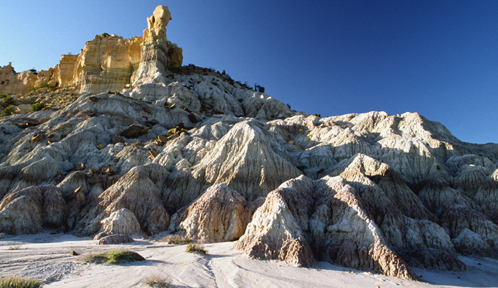
So it’s not without a little guilt that I say the virtually unknown Lybrook badlands eclipse the Bisti both in scenic and recreational appeal. Larger in size, they surpass the Bisti in the complexity of their multi-level topography, in the variety of hoo doo styles and coloration, and certainly in the beauty of the pygmy conifer forests which add so much color and detail to the hikes. If the Bisti represents an abstract, other worldly dreamscape then Lybrook is a well-designed, lavishly landscaped sculpture garden. It offers grandeur and rugged cross country hiking, but also numerous, shaded alcoves and intimate galleries showcasing the smaller scale statuary and superb trees.
Lybrook’s box canyon riddled mesas drop over 700 feet in four distinct stair steps. Carved from a widespread San Juan Basin rock layer sequence known to geologists as the Nacimiento Formation, these multicolored sandstone, mudstone, and shale layers began forming about 63 million years ago and span 10 million years of earth history. The ancient layers’ diversity are responsible for the scenic variety at Lybrook and reflect the rich environments and biological communities that existed in the San Juan basin long ago.
The Nacimiento layers started forming during the Paleocene Period in early Tertiary times. The dinosaurs had vanished and early mammals were gaining a foothold in the basin’s lush forested floodplains. Erosion from the rapidly rising San Juan Mountains to the north produced huge amounts of sediments transported by rivers and dumped into the basin. The resulting maze of forested river deltas, meandering streams, wetlands, bogs, and freshwater lakes left plentiful mammal fossils, along with widespread petrified wood caches.
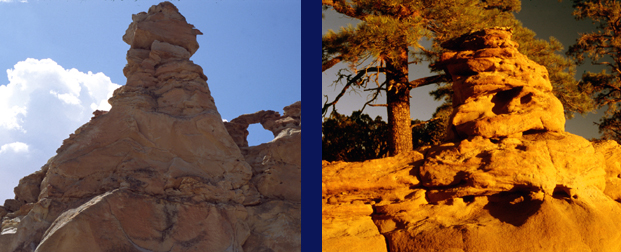
Periodic volcanic ash showers from the rapidly rising San Juan Mountains brought extra silicates and colorful minerals greatly enriching the ever thickening deposits that would later become the perfect medium for nature’s sculpting prowess. The excellent fossil record at Lybrook shows that mammals were still small and vulnerable. The top predator at the time was a fearsome 10 feet tall flightless bird with vicious beak and massive claws called the Diatryma.
The Nacimiento Formation tells a detailed and interesting story about ancient environments, but it’s just one chapter from a whole novel written in the ten sequential sedimentary layers underlying the San Juan Basin. This gentle depression has been collecting sediments for about 160 million years since the middle dinosaur age. A few relatively large time gaps interrupt the resulting 2 mile thick sedimentary layer cake, but beginning about 100 million years ago, a nearly continuous record of ancient environments is preserved in the stacked layers, or “formations”, up until about 40 million years ago.
The basin didn’t take its saucer-like shape until 20 million years ago when widespread faulting, volcanism, and uplift along the boundary exposed older, underlying layer edges to the elements and accelerated erosion. One look at a color coded, regional geologic map presents a clear picture. Warped upward along their perimeters, the exposed, relatively thin layer edges form huge concentric circles with the oldest, bottom layers at the basin’s outer reaches and the youngest, topmost layers in the center.
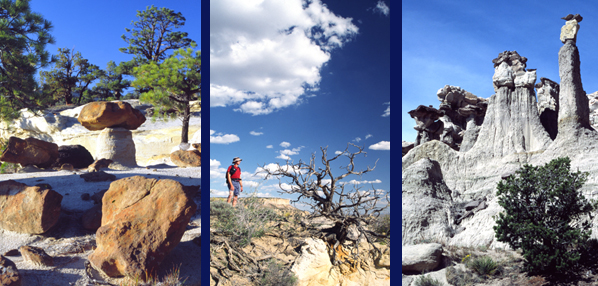
The Nacimiento Formation lies second from the top in the time sequence. Just above it, the most recent, topmost layer called the San Jose Formation actually forms a disk at the basin’s center. Two formations below and farther out from the center, the Bisti Badlands are carved from the 70 million year old, late Cretaceous Kirkland/Fruitland formation deposited when the last of the dinosaurs roamed the shores of a retreating inland sea.
The Lybrook badland’s initial complexity reveals a fairly simple pattern. The stair step tops are formed from tough, red and orange sandstone, the sides from more easily eroded, grey mudstone and shale. These two rock types produce two distinct hoo doo types. Those along the sandstone mesa edges are more precisely carved, either into multi-colored, striated domes and hoo doo clusters, with occasional arches, or solitary columns balancing intricately defined cap rocks. While below, the monochromatic mudstone hoo doos grow out from cliff bases like a chaotic garden of alien flora. Formed from raw earth, they have an eerie visceral quality that is almost organic.
Dirt road access off US 550 to the badlands’ upper edges is short and relatively simple but the cliffs separating the stair steps complicate any long distance hiking. Easy routes between the levels are limited and difficult to find. Steep walled box canyons cut the steps into disconnected balconies further complicating cross country travel. Most hikes involve either strolling the amazingly convoluted cliff edges past nonstop sandstone sculpture exhibits or getting pleasantly lost in the weird hoo doo mazes along the cliff bases below.
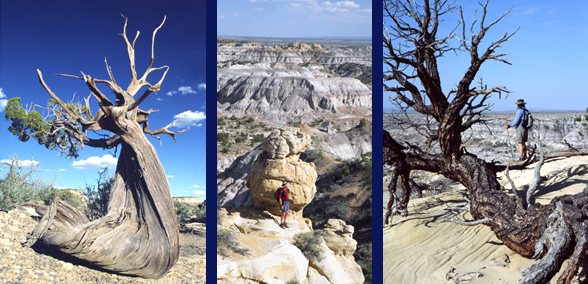
Exploring large portions of the badlands on one hike requires route finding skills, frequent backtracking and scrambling, some climbing, and ample water. Long loop hikes are pretty much impossible. But all that said, discovering every natural rock formation type imaginable as you wander this gigantic deserted sculpture garden makes the effort well worth while. For quickest access to the most impressive formations, day hikers should choose either the second step down from the top or the floor immediately below, depending on which type of hoo doos you want to see. Visitors staying a few days have almost limitless route choices. It would require 5-6 long hikes just to take a cursory look at the whole area.
The mesa edges not only offer dramatic statuary and stunning views, they also hold some of the most amazing bonsai ponderosa trees I’ve ever seen. No where is the battle for survival in the high desert more poignant. The closer the trees grow near the edge the more twisted and stunted they become. Often clawing at the rock and life by just one root, these struggling trees writhe with determination as they test every strategy to postpone inevitable death while their world erodes away. Lightening bolts have scarred many, as if wind, scare water, bare rock and searing sun don’t offer enough challenges. Nearby their downed, twisted skeletons, with intricate grain patterns embossed by a patina of time and the elements, seem almost as beautiful as the ones who struggle on.
The spooky grey hoo doo galleries below hold so many strange shapes and exotic textures that their relative lack of coloration is no drawback. Really exploring this sprawling mudstone labyrinth resembles a marathon obstacle course through some weird amusement park. Always use due caution, especially during or after precipitation, when entering the innumerable steep-walled, narrow washes, cavities, and overhanging grottos, some fifty feet high. Cave ins, small slides, flash floods, or falling through thin crust into sink holes present real dangers.
In the larger sandstone box canyons, water drainage areas along the cliff bottoms shelter small wildflower meadows and huge, ram road straight ponderosa in contrast to their stunted, tormented cousins above. Keep an eye out for wildlife. Mule deer and coyotes roam freely; large raptor numbers indicate a rich small mammal and reptile population.
“Badlands” is a judgmental term from a strictly human viewpoint. These maligned tracts often have greater species density and diversity than the lands we deem more useful. They also posses an intricate, paradoxical beauty that simultaneously fires the imagination and tickles the funny bone. All the art objects in the world’s finest museums pale in comparison with the art at Lybrook. And you can get a great workout seeing it, along with as much exciting cross county hiking and scrambling as you want.
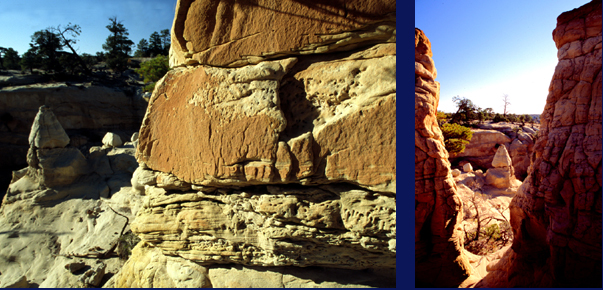
| HOME |
GEOLOGY |
PHOTOGRAPHY TIPS | RECREATION | MAP - INDIVIDUAL BADLANDS |
| INDIVIDUAL BADLANDS PAGE | PHOTO TOURS |
BADLANDS OVERVIEW |
This site is property of PhotoTrekNM. All rights reserved. Copyright 2007.